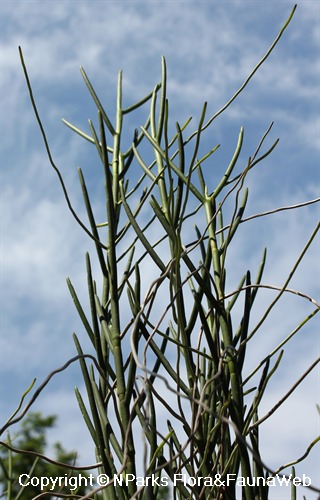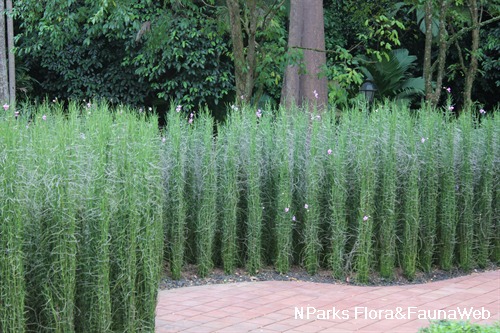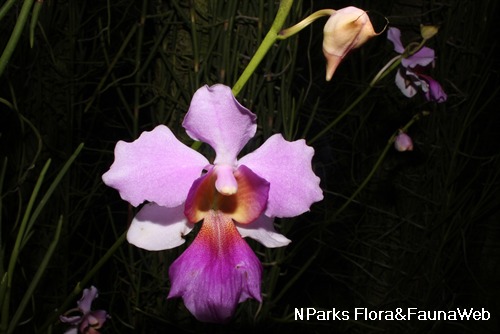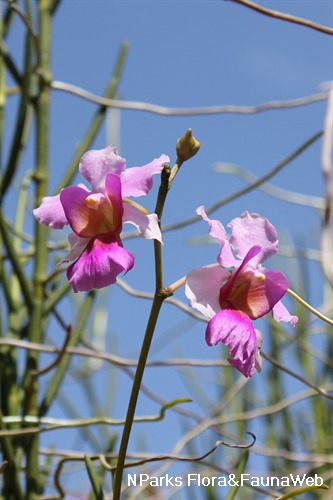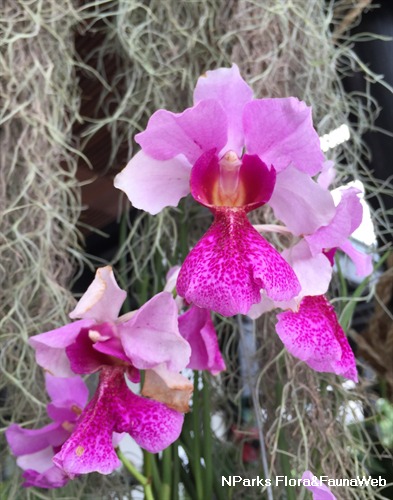
Back
Papilionanthe Miss Joaquim
| Family Name: | Orchidaceae |
| Synonyms: | Vanda Miss Joaquim |
| Common Name: | Vanda Miss Joaquim, 卓锦万代兰 |
In 1981, Papilionanthe Miss Joaquim stood out from among 40 flowers and was chosen to be Singapore’s National Flower. Its bright colours, resilience, hardiness and free-flowering nature are qualities that reflect the Singapore spirit. The orchid is named after Miss Agnes Joaquim who successfully crossed the parent species, Papilionanthe teres (♀) and Papilionanthe hookeriana (♂) in 1893, creating Singapore’s first orchid hybrid!
Name
Classifications and Characteristics
| Plant Growth Form | Climber |
|---|---|
| Lifespan (in Singapore) | Perennial |
| Mode of Nutrition | Autotrophic |
Biogeography
| Preferred Climate Zone | Tropical |
|---|
Description and Ethnobotany
| Growth Form | This monopodial orchid hybrid has long, thin stems that require support. |
|---|---|
| Flowers | The flower is composed of 3 sepals, 2 petals and 1 lip (6 cm high, 5 cm wide). The sepals are the top and lower pair of petal-like structures. Petals are larger and more round than the ovalish sepals. The top sepal and petals are light pink, while the lower sepals are white. The angel-shaped lip in the middle is bright pinkish purple with an orange center that has reddish to purple spots. An inflorescence consists of up to 12 flowers, but typically only 4 flowers are mature at the same time. This hybrid is free-flowering, producing blooms throughout the year in Singapore. |
| Taxonomy | Parentage is Papilionanthe teres (pod parent) and Papilionanthe hookeriana (pollen parent). Papilionanthe Miss Joaquim is the current scientifically accepted name, but Vanda Miss Joaquim is a widely known synonym in Singapore. |
| Cultivation | This slow-growing hybrid does best in an open, sunny location with humid, but not stagnant air. It requires heavy fertilization for optimal flowering. The slender stems should be tied to posts for support. The top of the plant needs to grow 40 - 50 cm above the post before it will begin to flower. |
| Etymology | Papilionanthe Miss Joaquim is named after Agnes Joaquim (1854 – 1899) who crossed the parent orchids to obtain this hybrid in 1893. H.N. Ridley, former Director of the Singapore Botanic Gardens, stated that the two parent species were "cultivated in almost every garden in Singapore” in the June 1893 Gardeners’ Chronicle. |
Landscaping Features
| Desirable Plant Features | Ornamental Flowers |
|---|---|
| Landscape Uses | Flowerbed / Border |
Fauna, Pollination and Dispersal
| Seed or Spore Dispersal | Abiotic |
|---|
Plant Care and Propagation
| Light Preference | Full Sun |
|---|---|
| Water Preference | Moderate Water |
| Planting Remarks | High humidity is required. |
| Fertilizing | Heavy fertilization encourages good growth and flowering |
| Propagation Method | Seed, Stem Cutting, Tissue Culture |
Foliar
| Foliage Retention | Evergreen |
|---|---|
| Mature Foliage Colour(s) | Green |
| Leaf Area Index (LAI) for Green Plot Ratio | 3.5 (Shrub & Groundcover - Monocot) |
Floral (Angiosperm)
| Flower & Plant Sexuality | Bisexual Flowers |
| Flower Colour(s) | Pink, Purple |
|---|---|
| Flower Symmetry | Bilateral |
Fruit, Seed and Spore
| Fruit Type | Dehiscent Dry Fruit |
| Seed Description | Numerous, dust-like seeds lacking endosperm |
|---|---|
| Seed Quantity Per Fruit | Numerous (>20) |
Image Repository
Others
| Master ID | 1246 |
|---|---|
| Species ID | 2539 |
| Flora Disclaimer | The information in this website has been compiled from reliable sources, such as reference works on medicinal plants. It is not a substitute for medical advice or treatment and NParks does not purport to provide any medical advice. Readers should always consult his/her physician before using or consuming a plant for medicinal purposes. |

